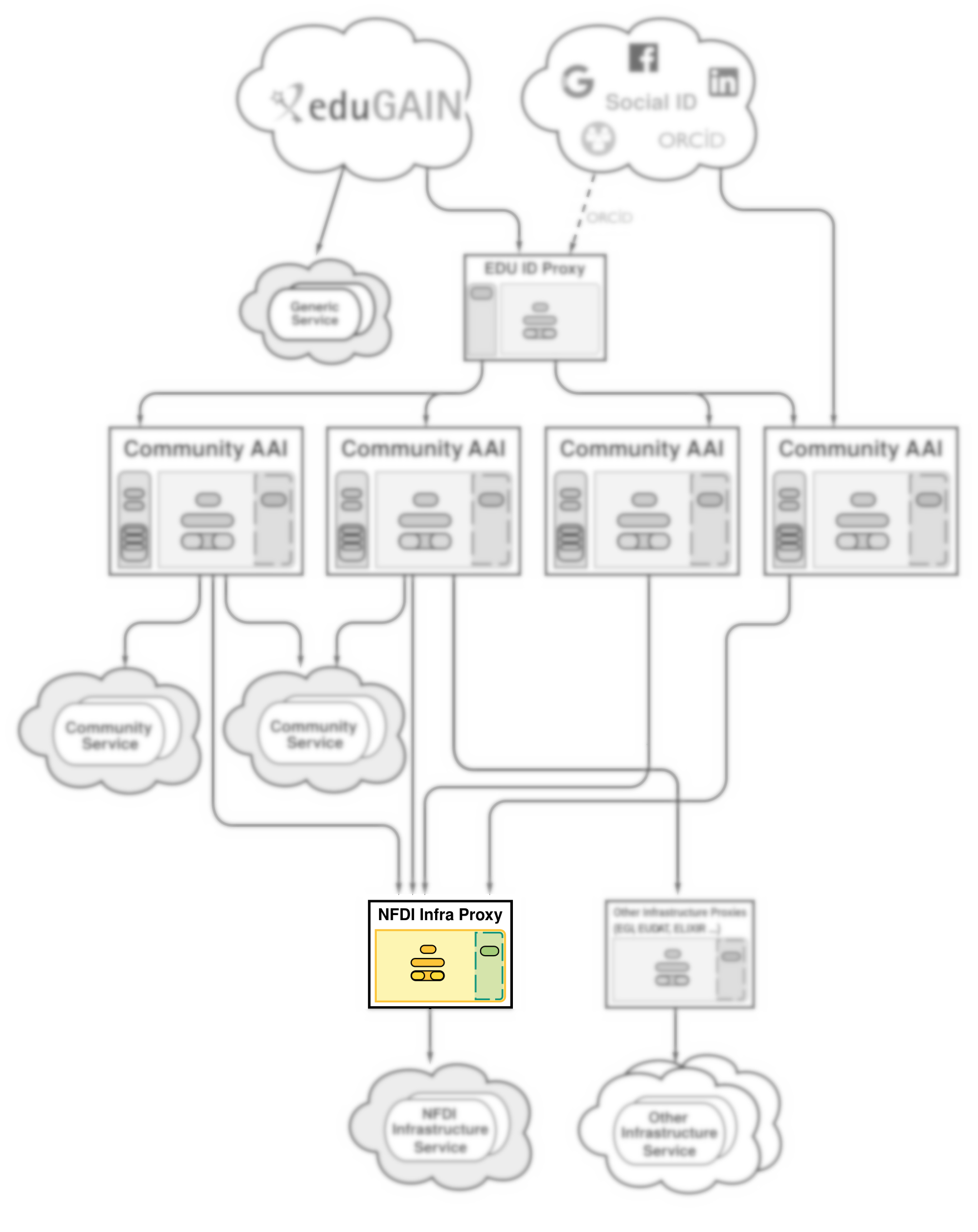
Architecture#
Introduction#
The NFDI Architecture supports the AARC-Blueprint-Architecture (proxy model) and AARC-BPA-2019 (which splits “Community AAI” and “Infrastructure-Proxy”).
The Architecture enables:
-
Users (from DFN AAI, eduGAIN, ORCID, Google, etc., …) to authenticate to NFDI services that may be integrated at different levels of the architecture, depending on the requirements and scope of the service.
-
Communities (e.g. an NFDI-Consortium) to manage group memberships to organise access rights.
-
Service Owners to
- easily integrate their services
- authorise on a well defined set of attributes
Architecture Diagram#
The diagram of the architecture looks quite complex. It is described below, and should (will) become clearer.
Note, that the architecture makes no assumption which protocols are being used between the different entities. In principle SAML and OpenID Connect (OIDC) are possible in each step. In practice academic identities and existing services use SAML, while commercial providers (e.g. google, microsoft) and other services use OIDC.
X.509 user-certificates may also be used at different places, but there is a general trend to deprecate them (for user authentication).

Architecture Components#
The details of the Architecture Components are defined in the 2019 version of the AARC Blueprint Architecture. We repeat the core aspects here.
Identity Providers#
Identity providers (IdPs) are defined as the place where the user ultimately authenticates. This may be by using a password, a certificate, involve a 2nd factor, etc. Different Identity providers have different identity qualities, expressed as levels of assurance using the REFEDS Assurance Framework (RAF). Here, these IdPs (e.g. Shibboleth) are typically from home institutions, but other common services can also be used (e.g. ORCID).

Edu-ID Proxy#
The edu-ID system will provide a life-long persistent ID to researchers, even if they use different Home Identity Providers. Some details for the use of the edu-ID proxy are still under development, as such its use is currently optional, but its place in the architecture is already fixed. Furthermore, it can be used for account linking and as a central Guest/Homeless IdP. For more information, please refer to the documentation.

Community AAI#
Community AAIs are web platforms that allow a community (e.g. an NFDI-Consortium) to manage themselves. This includes in particular VO and group memberships, and applies to all attributes about a user, including persistent identifiers. The available software products to run the NFDI Community AAI Architecture are described here in more detail .

Infrastructure Proxy#
There will be a single infrastructure proxy, operated by the AAI Team. This proxy component requires substantial development which is planned to be carried out within the upcoming Base4NFDI project. For connecting services to the Infrastructure Proxy, please refer to this checklist The infrastructure proxy serves multiple purposes:
- Simplify the connection of NFDI services (i.e. such services that
serve more than a single Community). All services connected to the
Infrastructure Proxy will immediately be able to consume
- Users from eduGAIN, ORCID, and Social Providers (Google, ...)
- VO membership information from the Community AAI through wich a user authenticated - Authorisation. Some services may not be able to understand the authorisation attributes, or to act accordingly. For such services (that should be an exception) the Infrastructure Proxy may be configured to take the authorisation decision for the service (i.e. by not redirecting an unauthorised user to that service).
- Identity Linking. Some users have multiple identities. This may be intentional or not. Causes may be that either different Community AAIs are used between subsequent logins, or that the Home-IdP or a "Social" IdP is used in different logins. The Infrastruture Proxy may combine these logins which are then presented as a consistent single identity to the service.

Services#
NFDI Services may be connected at three different layers in the architecture:
- Services connected directly to the Home-IdPs (in eduGAIN, or any subset of it, such as DFN AAI) are called Generic Services . These do not receive any Community related attributes, and are accessible without the need to use a Community-AAI. Consequently, generic services cannot access Community Specific attributes, such as VO memberships and the community identifier.
Migrating a generic service to the Community AAI is a major change, since the attribute sets released by Home-IdPs and those released by Community-AAIs may differ substantially. - Services connected to a Community AAI are called Community Services. They obtain the attribute set described in the attributes section, including VO membership or Resource Entitlements (see Authorisation section). Community Services are typically accessible by a single community only.
- Services connected to the Infrastructure Proxy Infrastructure Services. They obtain the same attribute set as Community Services, and can therefore be migrated very easily. Infrastructure services are accessible by all Communities (i.e. if the appropriate authorisation criteria are met).

Other Infrastructur Proxies and Services#
In principle, it is possible to connect other NFDI services and proxies to one or more CAAIs, if they follow the specified attribute scheme and policy framework.

Last change: Dec 15, 2025 15:35:48